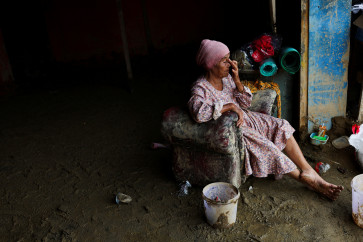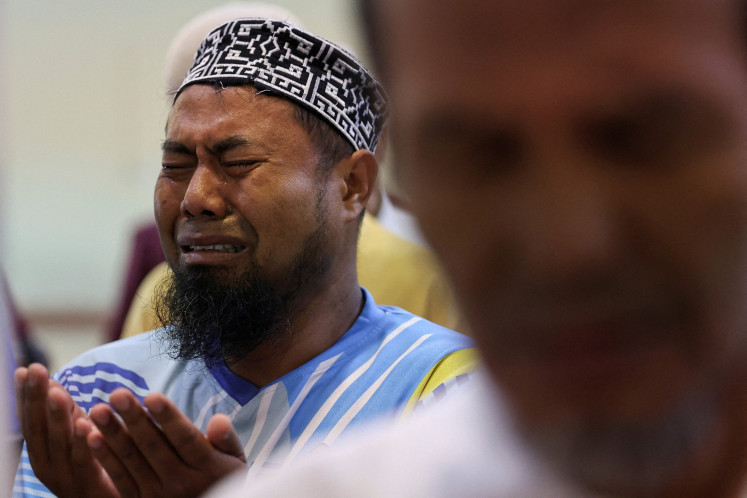Popular Reads
Top Results
Can't find what you're looking for?
View all search resultsPopular Reads
Top Results
Can't find what you're looking for?
View all search resultsWeaving heritage
(jakplus
Change text size
Gift Premium Articles
to Anyone
(jakplus.com/Swastika Nohara)
IN FLORES, LOCAL WISDOM ON A PIECE OF CLOTH
The island of Flores in East Nusa Tenggara has more to offer than magnificent landscapes.
Locally made hand-woven textiles known as tenun ikat are one of the island's treasures, crafted with heart and soul in a traditional way ' and often with all natural ingredients.
Each region on the island, such as Lembata, Sikka, Maumere, Ende, Manggarai, Ngada and Lio, produces ikat with a distinctive pattern and color.
During a recent visit to the village of Jopu in Ende regency, I met with local residents whose families have been making ikat for generations.
Jopu, located in the west of Ende, is a town travelers typically encounter on the way to Mount Kelimutu.
In the village, there is one traditional house, the Sao Ata Mosa Lakitana, that stands tall as it is surrounded by more modern yet modest establishments.
The roof is so high that it can be seen from a surprising distance. It is a sacred place where traditional ceremonies are held in April and October.
A woman in her forties named welcomed us. People introduced her as Mama Maria. She told us an interesting story behind the ikat.
In the context of the textile, the people of Ende are closely related to those of Lio. Indeed, they're often referred to as Ende-Lio, and the two closely linked ethnic groups are well known as skillful makers of ikat. Ikat originates from a Javanese word that means to tie, or can be used as a noun that means thread or knot.
It also describes a technique used to create textile patterns that employs resist dyeing prior to dyeing and weaving a fabric. The resulting textiles are usually worn as sarong.
The Ende-Lio ikat sarongs typically have a maroon base, woven and sewn twice by separating the middle part and the leg part.
Women's sorongs feature a middle section that is more intricate then that used by men, who favor sarongs with black or blue-black bases and horizontal bold stripes.
While men's ikat are decorated with simple thick and thin stripes, the women's are adorned with flowers, leaves or even motifs of animals such as horses, birds, lizards or the island's famous Komodo dragons.
The patterns have been influenced by the patola, a type of double-woven ikat sari from India, brought to the island by Portuguese merchants in the 16th century.
There's also some Javanese influence evident in the use of the Jelamprang pattern, which is also widely used in batik that favors motifs of tree branches and leaves.
Men and women also wear their ikat sarongs differently.
Men slip into their sarongs from the head, then fold the remaining fabric on their left and right into the middle of the body, and then rolling the remainder from the chest to the stomach.
While complex, the end result is a neatly tucked in sarong that is aligned with its horizontal pattern.
Meanwhile, women simply wrap the sarongs around their bodies, fold them so that they fall right under the chest, again folding from right to left, and tucking the remaining fabric into the sarong on the abdomen.
These sarong, or lawo as local residents call the garment, have several versions.
There are simple lawo for daily use and special lawo for traditional ceremonies and celebrations. They even wear lawo to keep themselves warm during the night. At first I was not convinced that a lawo could keep me warm, so I wore one on a short hiking trip to Mt. Kelimutu.
We left at 4:30 a.m. when it was cold. I was amazed at how the thick weave of my lawo kept me warm the whole morning, even when it was very windy on the mountain top.
Mama Maria shares stories of lawo with great enthusiasm. Her hands moved animatedly as she spoke, sometimes caressing the lawo she was wearing that afternoon.
She said one good lawo could take four to five months to make.
Originally, people use natural colorings, such as indigo leaves, to make the blue dye and noni leaves to make red or yellow dye.
While lawo made with traditional dyes can cost upwards of Rp 1 million, there are also lawo made using chemical dyes that are simpler to apply and resulted in brighter colors.
Makers today also mix traditional cotton yarn with fabric, which also results in less expensive lawo.
Mama Maria said that crafting textiles was a common job for women, who traditionally weave and dye at home as men worked in the field.
At the local market near the port of Ende, one small ikat shawl can be found for Rp. 100,000, while a bright colored sarong-size lawo costs around Rp 700,000.
At Ende market, vendors sell ikat from various regions of Flores in a variety of colors, sizes and pattern.
Whether using natural or chemical dyes, either one can make beautiful souvenirsfor our loved ones. (+)










